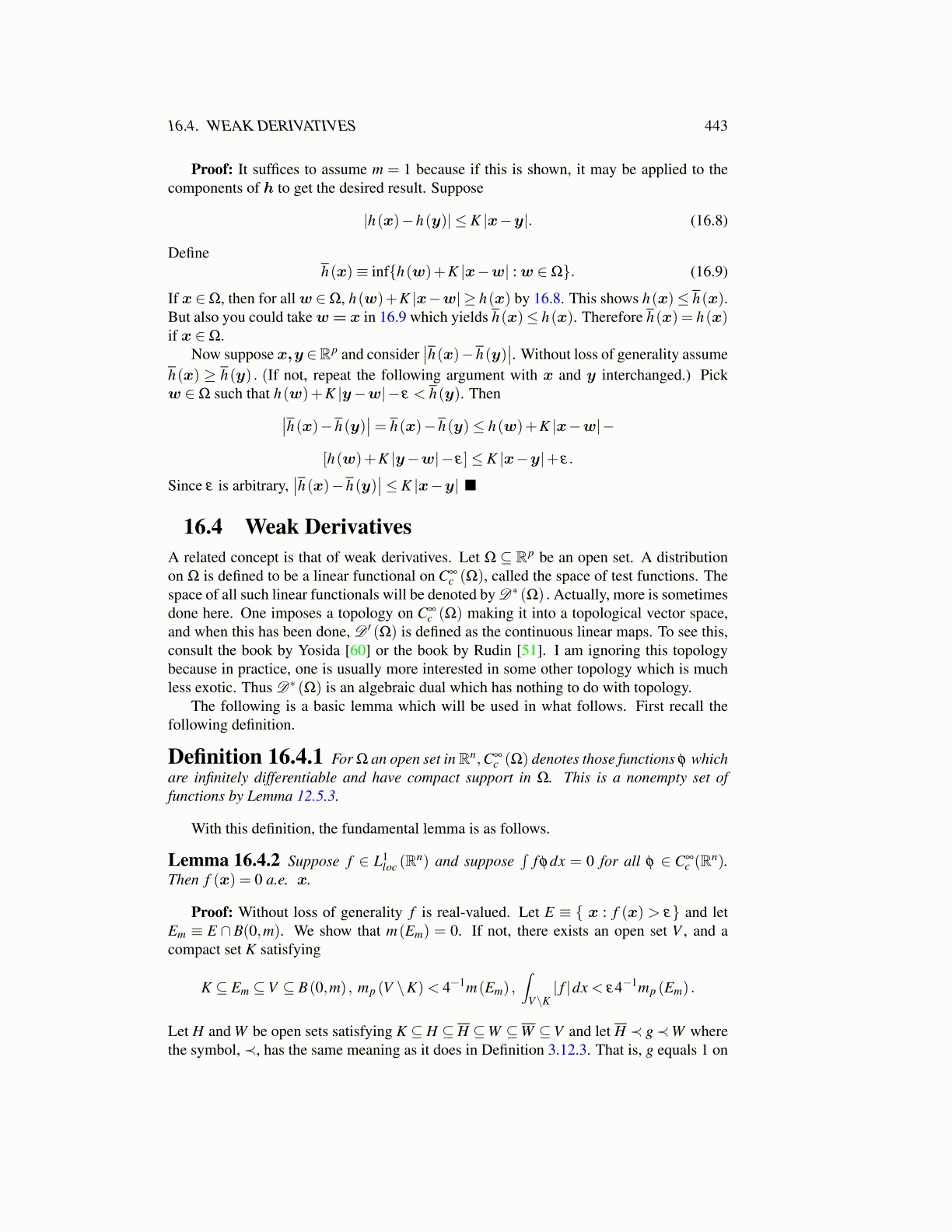
16.4. WEAK DERIVATIVES 443
Proof: It suffices to assume m = 1 because if this is shown, it may be applied to thecomponents of h to get the desired result. Suppose
|h(x)−h(y)| ≤ K |x−y|. (16.8)
Defineh(x)≡ inf{h(w)+K |x−w| :w ∈Ω}. (16.9)
If x ∈Ω, then for allw ∈Ω, h(w)+K |x−w| ≥ h(x) by 16.8. This shows h(x)≤ h(x).But also you could takew= x in 16.9 which yields h(x)≤ h(x). Therefore h(x) = h(x)if x ∈Ω.
Now suppose x,y ∈Rp and consider∣∣h(x)−h(y)
∣∣. Without loss of generality assumeh(x) ≥ h(y) . (If not, repeat the following argument with x and y interchanged.) Pickw ∈Ω such that h(w)+K |y−w|− ε < h(y). Then∣∣h(x)−h(y)
∣∣= h(x)−h(y)≤ h(w)+K |x−w|−
[h(w)+K |y−w|− ε]≤ K |x−y|+ ε.
Since ε is arbitrary,∣∣h(x)−h(y)
∣∣≤ K |x−y| ■
16.4 Weak DerivativesA related concept is that of weak derivatives. Let Ω ⊆ Rp be an open set. A distributionon Ω is defined to be a linear functional on C∞
c (Ω), called the space of test functions. Thespace of all such linear functionals will be denoted by D∗ (Ω) . Actually, more is sometimesdone here. One imposes a topology on C∞
c (Ω) making it into a topological vector space,and when this has been done, D ′ (Ω) is defined as the continuous linear maps. To see this,consult the book by Yosida [60] or the book by Rudin [51]. I am ignoring this topologybecause in practice, one is usually more interested in some other topology which is muchless exotic. Thus D∗ (Ω) is an algebraic dual which has nothing to do with topology.
The following is a basic lemma which will be used in what follows. First recall thefollowing definition.
Definition 16.4.1 For Ω an open set inRn,C∞c (Ω) denotes those functions φ which
are infinitely differentiable and have compact support in Ω. This is a nonempty set offunctions by Lemma 12.5.3.
With this definition, the fundamental lemma is as follows.
Lemma 16.4.2 Suppose f ∈ L1loc (Rn) and suppose
∫f φdx = 0 for all φ ∈ C∞
c (Rn).Then f (x) = 0 a.e. x.
Proof: Without loss of generality f is real-valued. Let E ≡ { x : f (x) > ε} and letEm ≡ E ∩B(0,m). We show that m(Em) = 0. If not, there exists an open set V , and acompact set K satisfying
K ⊆ Em ⊆V ⊆ B(0,m) , mp (V \K)< 4−1m(Em) ,∫
V\K| f |dx < ε4−1mp (Em) .
Let H and W be open sets satisfying K ⊆ H ⊆ H ⊆W ⊆W ⊆V and let H ≺ g≺W wherethe symbol, ≺, has the same meaning as it does in Definition 3.12.3. That is, g equals 1 on